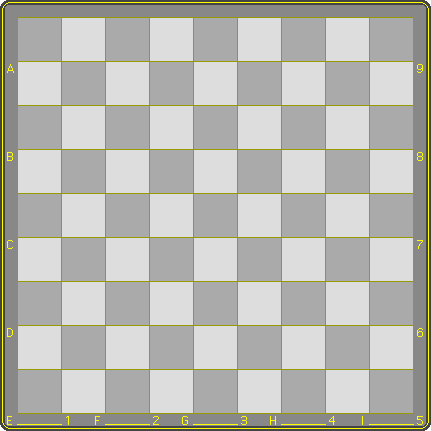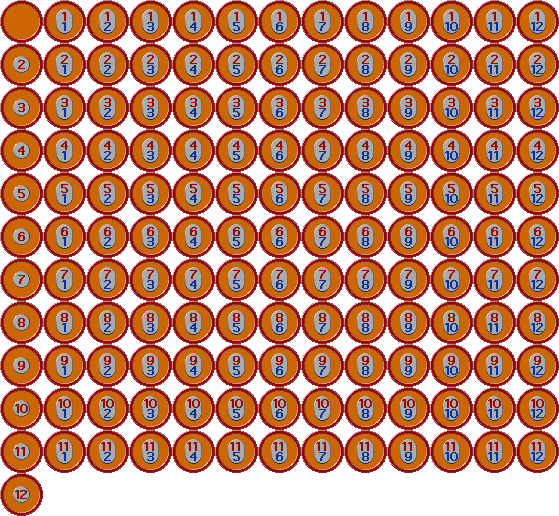Page 4 of 11
 |
In the 'Key concepts' chapter I've already discussed the characteristics of colum checkers. Basically it was what Ed van Zon showed me one day, insisting that 'very beautiful things' were happening there.
I had never been particularly interested in Stapeldammen and didn't even know it by that name, but rather as 'Indian Draughts'. It was played on a 10x10 board, like Draughts, usually with regular and thus far too thick draughtsmen, making it as much a game of manual dexterity as a boardgame. But Ed saw what I had failed to see: there was beauty flickering through the chaotic proceedings in the game. Using thin backgammon men he had me convinced in minutes.But there was this promotion issue: I felt that 'no promotion' would lead to an unsatisfactory conclusion, even if allowing promotion was altogether unsatisfactory. It didn't take me long to realize that 'forward direction' actually hampered the whole mechanism. In Checkers terms, all men should be kings to begin with. The inevitable conclusion was that the whole concept of an initial position, a forward direction and promotion should be abandoned.
Occam's razor - that was the starting point.
| It should be noted at this point that in retrospect I was dead wrong about 'no promotion' leading to an 'unsatisfactory conclusion'. Stapeldammen is a great game in which strategy for a large part revolves around the very fact that pieces can get stuck! What I initially discarded as 'less than elegant' is in fact essential to the strategic depth and profound beauty of the game. At the time my misconception was fortunate because it spurred us on to find Emergo. |
'All kings Lasca'
I suggested an 'entering stage' in which men should be entered one by one. Capture being compulsory, we both felt it should be the binding factor between the entering and movement stage. The alternative would be a flat entering stage, almost as if sneaking in an opening position of sorts after all. Moreover, preventing capture in the entering stage would require an extra rule and we both were rather fond of Occam's razor.
It's good to realize at this point that 'feeding' is an important concept in column checkers. Since capture is compulsory, it allows you to force an opponent to capture as many men as you can possibly feed him, while making sure beforehand that you can remove the guard(s) as part of the same combination. It leaves you with a large liberated column, which is good.
So we started putting men on the board in our first game, using no other rules than entering a man if not obliged to capture, and capturing in all directions. The movement stage would thus turn into an 'all kings Lasca'. Soon Ed had sneakily managed an anchorman waiting to capture a particular piece that he started feeding around the board. It followed his lead compulsory, like a dog. He eventually liberated a column of ten or thereabouts, and I was still stuck with a similar pile of men in hand - what later would be coined the 'shadowpiece'.
The shadowpiece
Five minutes later actually. It soon turned out that a phase where one player would have all men on the board, while the other was still forced to enter, was unsatisfactory. The player on the board would have little trouble eating the entered pieces one by one. So we decided that if one player had entered his last man, the other would have to enter his remaining men as one piece. Thus the players would always be 'on the board' on successive turns.
Negative feedback brings balance, and this was negative feedback for sure. If you fed a large number of men during the entering stage, to create a large piece, the opponent would get a comparable large piece, and be allowed to enter it, as a whole, on a square of his choice. That was something to seriously consider, before embarking on a feeding frenzy. It was immediately clear that the 'shadowpiece' would have considerable strategical implications.
This is typical for an 'organism': not only does it point to a solution itself, but the solution often has implications beyond merely solving the problem. That's why I love 'game whispering'.
The entering rule
We weren't there yet. The game 'worked' but the entering stage seemed to lack solidity. All proceedings in this 'free feeding' environment seemed dominated by tactics with no strategical anchors. We must have played for an hour or so, both feeling we were near but neither satisfied with the games erratic behaviour. I was sure however that the rule must exist and that we'd find it eventually. And we did.
The problem was clearly in the ad lib feeding, which prevented something like a 'position' to even arise. But preventing capture was out of the question. Capture was the binding factor between the entering and movement stages and thus part of the backbone of the whole mechanism. Then a thought hit me: what if it were dependent on the opponent's move, whether or not I would be allowed to feed? What if by attacking me, that is: by threatening a direct capture, he would allow me to enter anywhere? What if I wouldn't be able to feed as long as he would refrain from attacking any of my pieces?
It was an 'AHA-Erlebnis'. Eureka! It immediately gave the entering stage the solidity sought for, without affecting capture as a binding factor, or the shadowpiece as a strategical factor. It also implied, as soon came to light, that black and white would not have quite the same objectives in the entering phase - but you can read about that in the Emergo section.
| This simple rule - you may not feed in the entering stage unless you're already under attack - is somewhat enigmatic in that even seasoned players of abstract strategy games have been known to misinterpret it. |
Opposition clearly was an important weapon, so we decided for a board that would support is as much as possible. That turned out to be a diagonal plane without tric-trac corners. Thus the 9x9 board came to be, with twelve men per player - more than enough to get the game to fully display its infinite intricacies.
| |||||||||
Where Bushka is karate, and Dameo is judo, Emergo this is wrestling!
Unfortunately I lost my collection of problems in the SE Fireworks explosion in 2000, and I haven't yet found the time or energy to compose new ones, so the problems section is a bit meagre. I might fill it again, eventually, but good problems do take some time.





